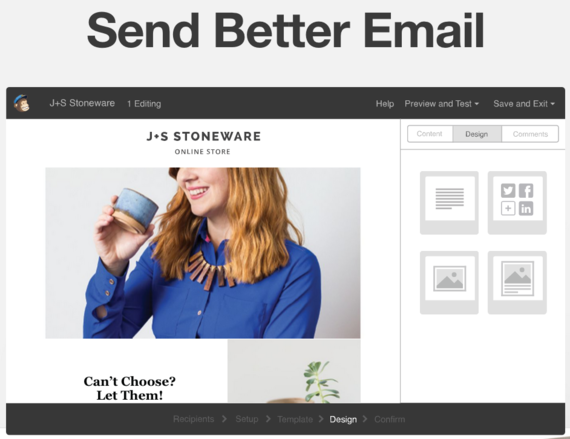Repurpose your best content to reach a larger audience.
Not everyone likes to read blogs. Therefore, creating other forms of content gives you an opportunity to engage people with different learning styles.
Content repurposing is also a long-term investment for your team.
"The process of repurposing can save you time and money and extend your initial content marketing investment, making it a worthwhile strategy," writes Arnie Kuenn, CEO of Vertical Measures.
Extend the shelf life of your great ideas. Here are five ways to repurpose your content:
1. Ebooks
E-reading is becoming more popular. At the end of 2014, 28% of adults had read an e-book‐a five percent increase from the previous year.
Repurposing blog posts into an ebook is a clever way to create lead generation content. Articles solving a similar problem can be combined to offer the reader a step-by-step solution.
North Dakota startup CoSchedule contributes the growth of its email list of more than 10,000 members to free marketing guides.
So, how do you actually create the ebook? Well, you can take the cumbersome route by using Microsoft Word and Adobe InDesign.
Or you can use an easier method called Papyrus. This tool gives you an online editing interface to create your ebooks. It also offers a drag and drop feature to create a beautiful cover page in minutes.
Once the ebook is ready, set up a landing page. Ask prospects to fill out a form to receive the free content.
Not only are you recycling your best material, you're also generating leads for your sales funnel. Win-win.
2. Podcasts
Podcasting is a great way to add personality to your brand. It gives your company an actual voice.
Moreover, podcasting isn't a fad. Edison Research reported that "one-third (33%) of all Americans 12 years of age or older now say they have listened to at least one podcast."
By converting written content into audio, you reach a whole new audience who may not have the time to read an article. This content form offers them an opportunity to learn more about your business, while they commute to work or take a lunch break.
If you're ready to hit the airwaves, try creating your podcast with Spreaker. This platform lets you create, host, and distribute your podcast from desktop and mobile devices.
- Record yourself reading the blog post.
- Discuss the main points of the article.
- Interview an expert regarding the topic of the post.
For each podcast, make sure you end with a call to action, like signing up for a newsletter, downloading an ebook, or visiting a specific site.
3. Case Studies
Case studies show potential clients how your business gets results. This effective marketing tool can improve brand awareness and increase sales. The key is to repurpose relevant content that offers value to the reader.
According to the Eccolo Media 2014 B2B Technology Content Survey Report, people prefer plain text case studies. So, ditch the slides and videos.
Neil Patel, co-founder of Crazy Egg, Hello Bar, and KISSmetrics, says, "Your case study can be 500 words, or 1500 words - as long as it gets to the point in a way that's free of fluff and filler."
Tell a story with your case study. Show how your business solved a problem that constantly haunted your client. How did you approach the issue? What tools did you use?
Then, end the story showcasing the amazing results. What did you achieve? How did these results help your client? Paint a vivid picture of how these same outcomes can be replicated for other customers.
Whatever you sell, give your audience a peek into how your products and services can change their businesses or personal lives.
4. Social Media Posts
Social media platforms have shifted how we talk to friends, interact with coworkers, and engage with strangers. With over 3 billion active Internet users worldwide, "close to 1.7 billion people have active social media accounts."
Take advantage of social media. Reshape your long-form articles into short-form Twitter, Facebook, and LinkedIn posts.
Also, consider making a presentation that includes the main ideas from your blog posts. Upload those slides to SlideShare.
Founder of HelpWithAgingParents.com Tonia Boterf implemented this strategy and created a year's worth of Twitter posts. Her extensive content library also landed her radio guest speaker gigs.
Don't just regurgitate the same published information. Instead, post helpful bits of content, like inspirational quotes and snazzy tips. You want to hook your followers, and link back to the referenced blog.
From image sourcing to writing, developing social media posts takes effort. If you don't have the time or skill for such a task, consider outsourcing this work to an experienced content strategist.
Whatever you decide, search your archives and start repackaging your content.
5. Email Series
Let's face it. All your website visitors will not read every article you publish. Some may only visit your site twice a month.
To keep infrequent visitors engaged, create an email series made of previously published blog posts. This informative content can transform into a mini-ecourse for busy professionals who enjoy reading on the go.
In addition, an email series helps you grow your list. "[M]aking money with email lists has been proven to be extremely effective," says Matthew Allen of Dumb Passive Income.
"It is so effective that it is pretty much mandatory that any and every website owner should be building and growing their email list."
Use an email marketing tool, like MailChimp. This tool lets you create emails and set up an autoresponder to distribute them to specific subscribers.
Offer Variety
Repurposing content lets you appeal to various audiences. Add value to your original content by transforming it into several formats.
From ebooks to social media posts, your team can share new stories and insert the latest research. Moreover, your content creators can save time.
Find purpose in old content. Create something different.
How will you repurpose your content? Leave a comment below.


